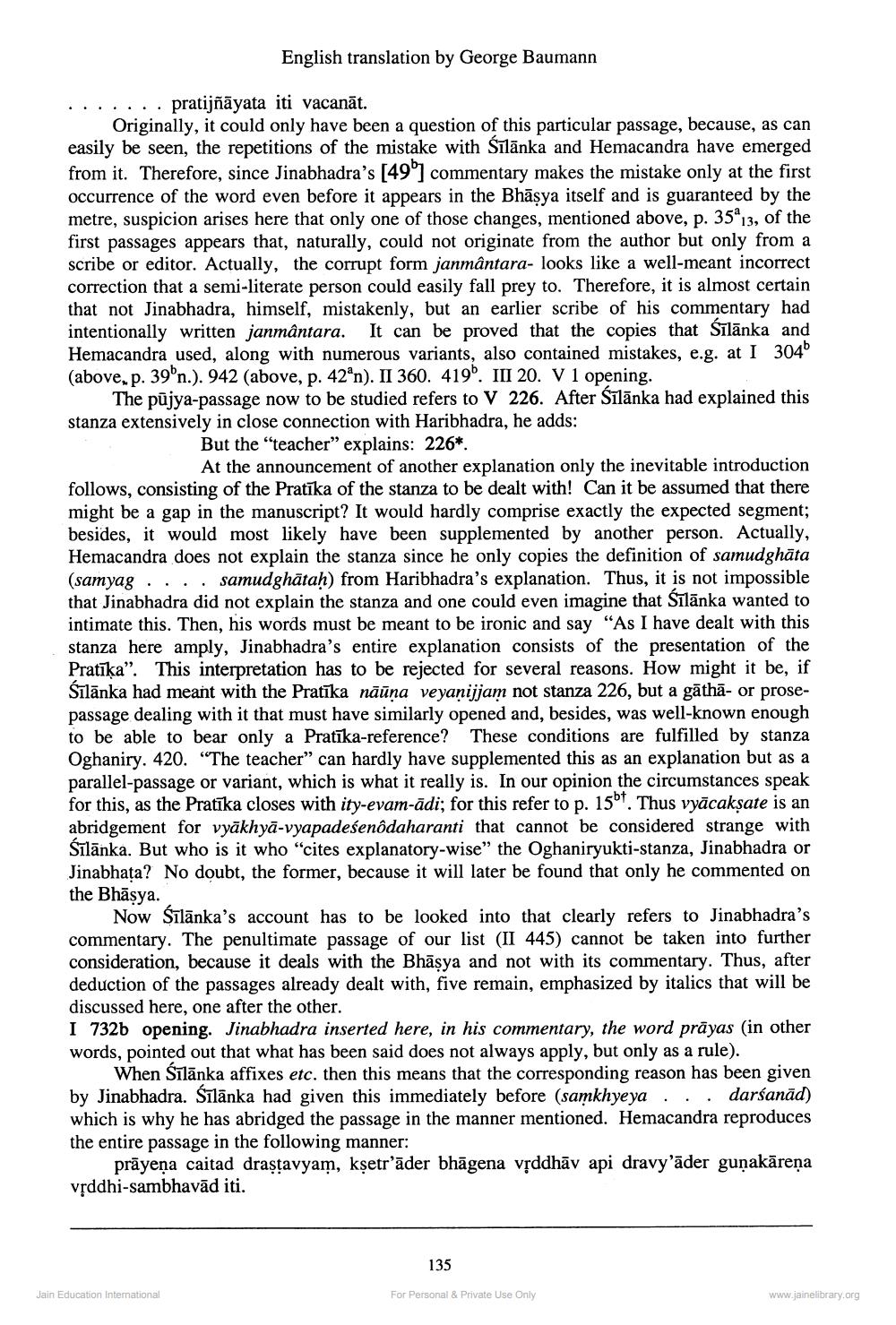________________
English translation by George Baumann
pratijñāyata iti vacanāt.
Originally, it could only have been a question of this particular passage, because, as can easily be seen, the repetitions of the mistake with Śīlānka and Hemacandra have emerged from it. Therefore, since Jinabhadra's [49] commentary makes the mistake only at the first occurrence of the word even before it appears in the Bhāṣya itself and is guaranteed by the metre, suspicion arises here that only one of those changes, mentioned above, p. 35a 13, of the first passages appears that, naturally, could not originate from the author but only from a scribe or editor. Actually, the corrupt form janmântara- looks like a well-meant incorrect correction that a semi-literate person could easily fall prey to. Therefore, it is almost certain that not Jinabhadra, himself, mistakenly, but an earlier scribe of his commentary had intentionally written janmântara. It can be proved that the copies that Sīlānka and Hemacandra used, along with numerous variants, also contained mistakes, e.g. at I 304b (above, p. 39°n.). 942 (above, p. 42°n). II 360. 419. III 20. V 1 opening.
The pūjya-passage now to be studied refers to V 226. After Sīlānka had explained this stanza extensively in close connection with Haribhadra, he adds:
But the "teacher" explains: 226*.
At the announcement of another explanation only the inevitable introduction follows, consisting of the Pratīka of the stanza to be dealt with! Can it be assumed that there might be a gap in the manuscript? It would hardly comprise exactly the expected segment; besides, it would most likely have been supplemented by another person. Actually, Hemacandra does not explain the stanza since he only copies the definition of samudghāta (samyag... samudghataḥ) from Haribhadra's explanation. Thus, it is not impossible that Jinabhadra did not explain the stanza and one could even imagine that Sīlānka wanted to intimate this. Then, his words must be meant to be ironic and say "As I have dealt with this stanza here amply, Jinabhadra's entire explanation consists of the presentation of the Pratīka". This interpretation has to be rejected for several reasons. How might it be, if Sīlānka had meant with the Pratīka nāūņa veyaṇijjam not stanza 226, but a gāthā- or prosepassage dealing with it that must have similarly opened and, besides, was well-known enough to be able to bear only a Pratīka-reference? These conditions are fulfilled by stanza Oghaniry. 420. "The teacher" can hardly have supplemented this as an explanation but as a parallel-passage or variant, which is what it really is. In our opinion the circumstances speak for this, as the Pratīka closes with ity-evam-ādi; for this refer to p. 15bt. Thus vyācakṣate is an abridgement for vyakhya-vyapadesenôdaharanti that cannot be considered strange with Sīlānka. But who is it who "cites explanatory-wise" the Oghaniryukti-stanza, Jinabhadra or Jinabhata? No doubt, the former, because it will later be found that only he commented on the Bhāṣya.
Now Śīlānka's account has to be looked into that clearly refers to Jinabhadra's commentary. The penultimate passage of our list (II 445) cannot be taken into further consideration, because it deals with the Bhāṣya and not with its commentary. Thus, after deduction of the passages already dealt with, five remain, emphasized by italics that will be discussed here, one after the other.
I 732b opening. Jinabhadra inserted here, in his commentary, the word prayas (in other words, pointed out that what has been said does not always apply, but only as a rule).
When Silanka affixes etc. then this means that the corresponding reason has been given by Jinabhadra. Śīlānka had given this immediately before (samkhyeya darśanad) which is why he has abridged the passage in the manner mentioned. Hemacandra reproduces the entire passage in the following manner:
prayeṇa caitad draṣṭavyam, kṣetr'āder bhāgena vṛddhāv api dravy'äder guṇakāreņa vṛddhi-sambhavad iti.
Jain Education International
135
For Personal & Private Use Only
www.jainelibrary.org




